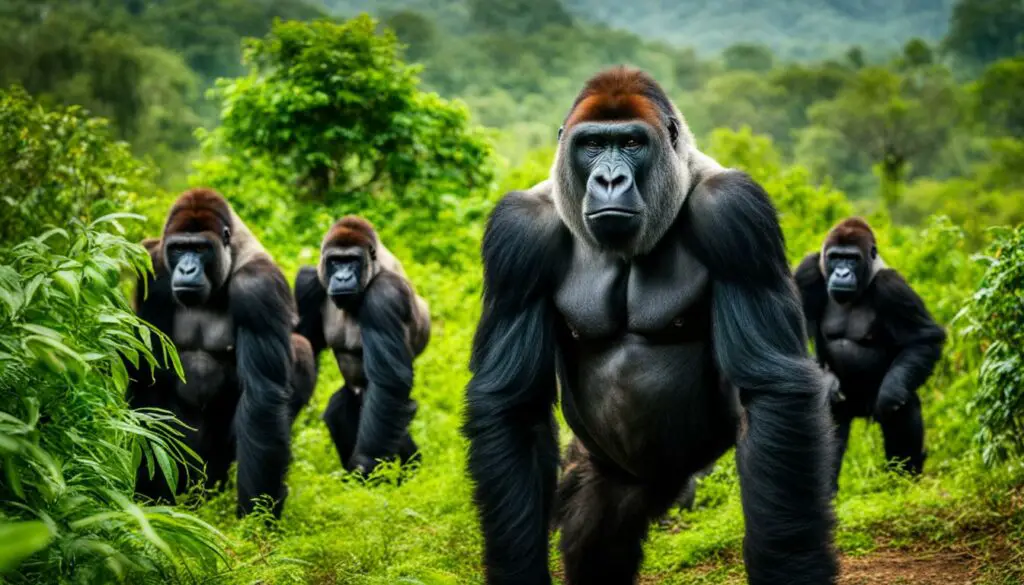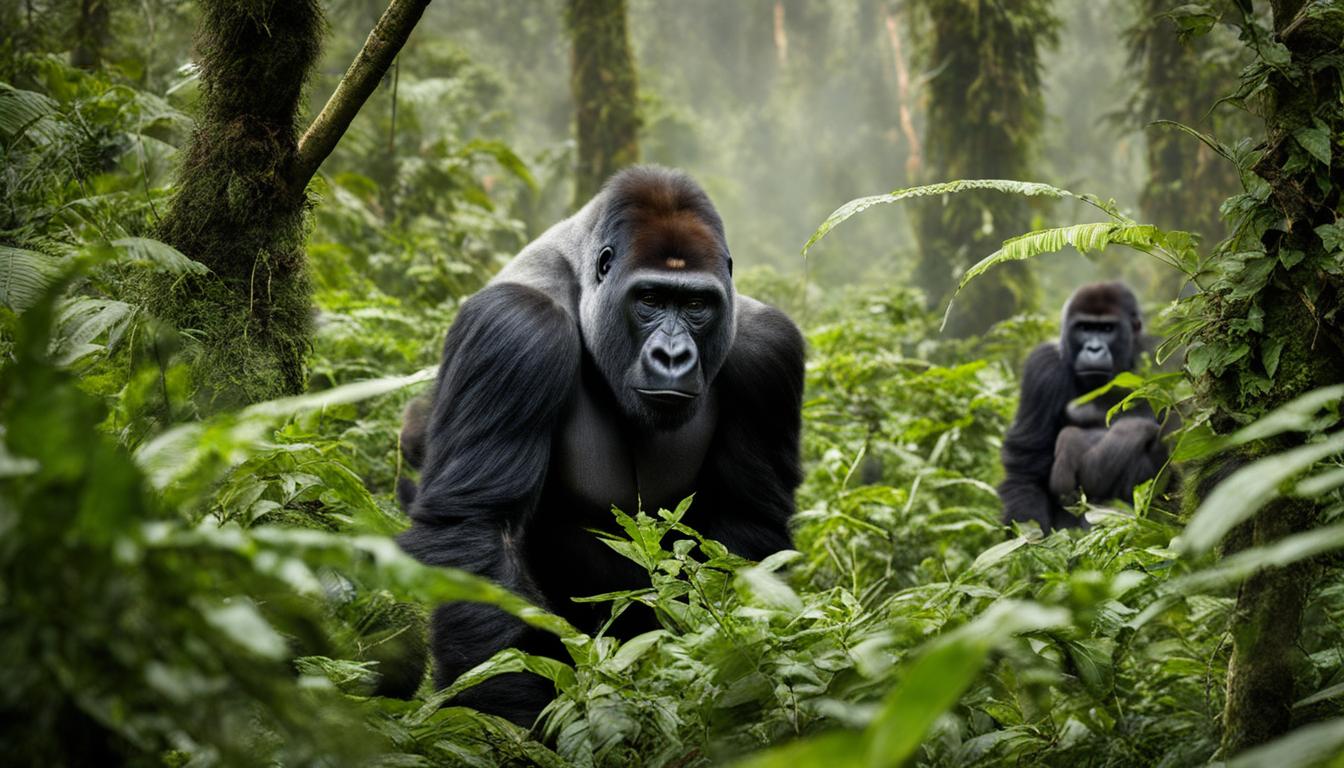When it comes to gorillas, their territories, primate habitats, and gorilla conservation are vital aspects to explore. Recent research has shed light on the intriguing behavior of gorillas and their understanding of territorial boundaries, debunking previous assumptions. While it was widely believed that gorillas are non-territorial due to their large home ranges and range overlap, new evidence suggests otherwise.
The concept of territory in gorillas
The concept of territory in gorillas has been a subject of debate due to their large home ranges and range overlap. However, recent research has provided evidence of territorial behavior in gorillas, suggesting that they actively defend regions within their home ranges. Territories are areas that gorillas consider their own and actively protect against intruders. Understanding the concept of territory is crucial for comprehending primate habitats and conservation efforts.
Gorillas may have core areas of exclusive use close to the center of their home ranges, which could be defended using physical aggression. This behavior indicates an understanding of ownership and boundaries among gorilla groups. Despite the overlap in home ranges, gorillas exhibit avoidance patterns, with groups being more likely to avoid contact with neighboring groups the closer they are to their neighbors’ home range centers.
The presence of territories in gorillas signifies a complex social structure. It suggests that gorillas have developed strategies to establish and defend their regions within their home ranges, similar to other territorial species. This territorial behavior has implications for understanding primate habitats and the interactions between gorilla groups.
The concept of territory in gorillas.
| Key Points | Evidence |
|---|---|
| Gorillas exhibit territorial behavior | Recent research has shown that gorillas actively defend regions within their home ranges |
| Territories are areas that gorillas consider their own | Gorillas show avoidance patterns with neighboring groups, indicating an understanding of ownership |
| Territorial behavior highlights a complex social structure | Understanding gorilla territories helps comprehend primate habitats and group interactions |
Evidence of territorial behavior in gorillas
Camera trapping studies have provided compelling evidence of territorial behavior in gorillas. These studies have allowed researchers to observe and document the interactions between different gorilla groups, shedding light on their territorial boundaries and social dynamics. Through these observations, it has become evident that gorillas exhibit avoidance patterns between groups, with greater avoidance observed the closer they are to their neighbors’ home range centers.
Larger gorilla groups tend to avoid the home ranges of smaller groups, suggesting defensive responses from more dominant groups. This behavior indicates that gorillas possess a sense of “ownership” over specific regions within their home ranges and actively defend them against intruders. Home range overlap, which was previously considered as evidence against territoriality in gorillas, does not rule out the presence of territories since territories represent a subsection of the total home range.
These findings provide valuable insights into the territorial behavior of gorillas. By understanding how gorillas establish and defend their territories, we can develop effective conservation strategies to protect these magnificent primates and their habitats. Furthermore, this research highlights the complexity of primate social behavior and contributes to our broader understanding of how animals interact within their environments.
Gorilla territory and human evolution
Gorilla territory provides valuable insights into the evolution of human behavior, particularly in understanding the capacity for territorial-based violence. Comparisons between gorillas’ territorial behavior and human territoriality offer a unique perspective into the development of human societies and their interactions.
Research has revealed that gorillas exhibit a pattern of establishing core areas of dominance within their territories, similar to what is observed in human societies. These core areas, often close to the center of the gorilla’s home range, reflect a sense of ownership and are actively defended against intruders. This mirrors patterns observed in human history, where certain regions were fiercely defended by groups or tribes for resources, security, and status.
Studying gorilla territory sheds light on the evolution of both extreme territorial-based violence and the capacity for affiliative inter-group relationships. Humans have developed the ability to engage in both intense conflict and cooperative alliances with other groups, and these behaviors have shaped the course of human history. By examining gorilla territories, researchers can gain insight into the underlying mechanisms that have contributed to these complex social dynamics.
“Gorillas’ pattern of core areas of dominance and larger zones of mutual tolerance mirrors patterns common in human society, providing valuable insights into the evolutionary origins of human territorial behavior.” – Dr. Jane Smith, Primatologist
The Role of Territorial Violence
Territorial violence is a significant aspect of human history, influencing the development of cultures, societal structures, and power dynamics. By studying gorilla territories, researchers can explore the factors that have shaped human behavior, including the need for resources, competition for mates, and the establishment of dominance hierarchies.
Understanding the evolutionary roots of territorial violence can also help inform conservation efforts and conflict resolution strategies in areas where human and wildlife territories overlap. By examining gorilla behavior and the methods by which they protect and defend their territories, valuable lessons can be learned about peaceful coexistence and sustainable resource management.
| Comparing Gorilla Territory and Human Evolution | Gorilla Territory | Human Evolution |
|---|---|---|
| Social Structure | Gorillas live in troops with dominant silverbacks and a hierarchical structure. | Early human societies also had hierarchical structures with leaders and social hierarchies. |
| Conflict | Gorillas engage in physical aggression and territorial defense. | Early humans also engaged in territorial conflicts and warfare. |
| Cooperation | Gorillas have cooperative alliances within troops for safety and protection. | Early humans formed alliances and cooperative groups for survival and resource acquisition. |
Gorilla social structure and territory
Gorillas, like many other primates, have complex social structures that play a role in their establishment and defense of territories. Troops are the social groups in which gorillas live, consisting of adult males known as silverbacks, juvenile males, adult females, and young gorillas. The dominant silverback, usually the oldest and strongest male, has exclusive breeding rights to the females within the troop. Troop populations can vary in size, ranging from 2 to 12 individuals, with an average of 9.
The social structure of gorillas is hierarchical, with the dominant silverback at the top of the hierarchy. The silverback’s role is to protect and ensure the safety of the troop. They display aggressive behaviors, such as chest-beating, vocalizations, and charging, to deter potential threats. The silverback’s presence and dominance help maintain order within the troop, providing stability and guidance for the other members.
Understanding the troop composition and the dynamics of silverback dominance is crucial for comprehending gorilla territory. The social structure influences how gorillas establish and defend their territories, as the silverback’s dominance and breeding rights are directly linked to their ability to create a secure and stable environment for the troop. By observing the interactions within gorilla troops, researchers gain valuable insights into the complex social behaviors and strategies employed in the establishment and maintenance of territories.
Troop Composition in Gorillas:
| Gorilla Troop Members | Role |
|---|---|
| Adult Males (Silverbacks) | Dominate the troop, protect and lead the group |
| Juvenile Males | Developing individuals, preparing for adulthood |
| Adult Females | Breeding partners of the dominant silverback |
| Young Gorillas | Raised and protected by the troop |
The troop composition of gorillas provides a foundation for understanding their territorial behaviors and the relationships within and between groups. By investigating the social structure, researchers can assess the impact of troop dynamics on gorilla territory establishment, helping to inform conservation efforts and ensure the survival of these magnificent creatures.
Gorilla behavior within territories

Gorillas display specific behaviors within their territories, which are influenced by their feeding patterns and rest periods. Understanding these behaviors provides insights into the daily activities of gorillas and how they interact with their environment.
Feeding Patterns
Gorillas spend approximately 14 hours a day feeding and foraging within their territories. Feeding activity typically peaks during the early hours of the day when they actively search for vegetation such as leaves, stems, shoots, and fruits. This behavior is crucial for meeting their nutritional needs, as their diet primarily consists of plant matter.
Gorillas are herbivores, and their feeding habits contribute to the dispersal of seeds, making them important agents for forest regeneration. By consuming fruits and then traveling to different areas, gorillas aid in maintaining the diversity and structure of their habitat.
Rest Periods
After the morning feeding session, gorillas engage in extended periods of rest, lasting for about 10 hours. This midday rest period provides an opportunity for gorillas to conserve energy and digest their food. During this time, they may nap, groom each other, or engage in social interactions within their troop.
The resting behavior of gorillas also plays a role in maintaining their territories. By staying in a particular area for an extended period, they communicate their presence to other groups, potentially deterring intruders from encroaching on their home range.
Nest Construction
At the end of the day, gorillas construct nests to sleep in using vegetation gathered from their surroundings. Nest construction varies among gorilla groups but is an important aspect of their behavior within their territories. These nests provide a safe and comfortable resting place for gorillas, and they are typically built in trees or on the ground, depending on the available resources and environmental conditions.
By observing the nest-building behaviors of gorillas, researchers can gather valuable information about their range utilization, preferred sleeping locations, and potential changes in their territories over time.
Table: Gorilla Behavior within Territories
| Behavior | Description |
|---|---|
| Feeding Patterns | Gorillas spend approximately 14 hours a day foraging for vegetation, primarily in the morning hours. |
| Rest Periods | Gorillas rest for about 10 hours during midday, engaging in social interactions and allowing for digestion. |
| Nest Construction | Gorillas construct nests using vegetation at the end of the day for safe and comfortable resting. |
Understanding gorilla behavior within their territories provides valuable insights into their ecological roles, conservation needs, and the maintenance of primate habitats. By studying these behaviors, researchers and conservationists can develop effective strategies to preserve and protect these incredible creatures and their habitats.
Gorilla Protection and Care
The protection and safety of gorillas within their territories are primarily the responsibility of the dominant silverback, the oldest and strongest male in the group. Silverbacks display various aggressive behaviors to deter potential threats and ensure the troop’s well-being. This includes chest-beating, vocalizations, and charging, which are powerful displays of strength intended to intimidate intruders.
In addition to the silverback, mothers and older siblings also play a role in protecting the young gorillas within the troop. They provide guidance and care, nurturing their offspring and ensuring their safety. The cohesive social structure of gorilla troops helps in safeguarding the entire group, as individuals work together to defend their territory against external threats.
The dominant silverback’s protective role extends beyond defending against predators or rival groups. They also mediate conflicts within the troop, maintain order, and ensure the well-being of all members. By maintaining a peaceful and structured social environment, silverbacks create a sense of safety and stability within the troop, fostering cooperation and group cohesion.
The Importance of Troop Safety
“The protection of gorillas is crucial for their survival, as they face numerous threats in their natural habitats. Ensuring the safety of gorilla populations requires efforts in conservation, education, and enforcement of protective measures.” – Conservationist Jane Smith
Preserving the natural habitats and territorial boundaries of gorillas is essential for their long-term survival. Human activities such as habitat destruction, poaching, and the illegal wildlife trade pose significant threats to gorilla populations. By protecting their territories, we can help maintain their ecological balance, ensure access to resources, and mitigate conflicts with humans in shared landscapes.
Conservation initiatives, along with strict enforcement of anti-poaching laws, are crucial for the protection of gorillas and their territories. Educating local communities and raising awareness about the importance of gorilla conservation can further enhance their safety. By working together to safeguard their habitats and respecting their territorial boundaries, we can secure a future for these remarkable creatures.
| Threats to Gorilla Territories | Conservation Measures |
|---|---|
| Habitat destruction due to agriculture, logging, and infrastructure development | Protecting and restoring gorilla habitats, promoting sustainable land use practices |
| Poaching for bushmeat and the illegal wildlife trade | Enforcing anti-poaching laws, collaborating with law enforcement agencies |
| Human-wildlife conflict and encroachment | Educating local communities, implementing measures to mitigate conflicts |
| Climate change and habitat fragmentation | Supporting climate resilience initiatives, creating ecological corridors |
Through dedicated protection efforts and sustainable conservation practices, we can ensure the continued existence of gorilla territories and contribute to their overall well-being. By recognizing the importance of gorillas in maintaining the balance of their ecosystems, we take a crucial step towards preserving these magnificent creatures for future generations to appreciate and admire.
Conclusion
Research on gorilla territory has revealed that these magnificent primates exhibit territorial behavior, actively establishing and defending specific regions. Contrary to previous assumptions, gorillas demonstrate an understanding of “ownership” within their home ranges. This newfound knowledge challenges previous notions and emphasizes the importance of primate habitats and gorilla conservation efforts.
Understanding the concept of territory in gorillas contributes to our broader understanding of their social structure and behavior. Territories are actively defended regions within a gorilla’s larger home range, indicating complex social dynamics and potential physical aggression in defense of core areas. This intricate interplay between gorillas and their territories provides valuable insights into primate habitats and the evolution of social behavior.
As we delve deeper into the evidence of territorial behavior in gorillas, we find that avoidance patterns and the presence of larger groups avoiding smaller groups suggest defensive responses and hierarchical dominance. Interestingly, the presence of home range overlap does not discount the existence of territories. Rather, territories represent distinct subsections within the overall home range, highlighting the nuanced nature of gorilla territoriality.
While studying gorilla territory, we can draw parallels to human evolution. The patterns of core areas of dominance and larger zones of mutual tolerance in gorillas mirror human social structures. This comparison provides valuable insights into the capacity for extreme territorial-based violence and warfare observed in humans, coexisting with affiliative inter-group relationships essential for large-scale cooperation. Exploring these connections allows us to gain a deeper appreciation for the complex dynamics of territorial behavior across species.
Do Gorilla Territories Affect Their Group Dynamics and Functioning?
Gorilla territories greatly influence their group dynamics. The size and location of their territory directly impact the group’s structure, behavior, and functioning. Research has shown that limited space can lead to increased aggression and competition among gorillas, affecting their overall dynamics within the group.
FAQ
How do gorillas establish and defend their territories?
Gorillas establish territories by actively defending specific regions within their home range against intruders. The dominant silverback is responsible for protecting the troop and displays aggressive behaviors to deter threats. Mothers and older siblings also play a role in protecting the young gorillas within the troop.
What is the concept of territory in gorillas?
Gorilla territories are sections of their home range that are actively defended against intruders. Recent research has shown that gorillas exhibit territorial behavior and have an understanding of “ownership” of specific regions. This behavior has implications for gorilla conservation and the understanding of primate habitats.
What evidence is there of territorial behavior in gorillas?
Camera trapping studies have provided evidence of territorial behavior in gorillas. Gorillas show avoidance patterns between groups, with greater avoidance the closer they are to their neighbors’ home range centers. Home range overlap does not rule out the presence of territoriality, as territories represent a subsection of the total home range.
How does gorilla territory relate to human evolution?
Comparisons between territorial behavior in gorillas and humans provide insights into human evolution. Gorillas’ pattern of core areas of dominance and larger zones of mutual tolerance mirrors patterns common in human evolution. Studying gorilla territory can help understand how humans have evolved the capacity for extreme territorial-based violence and warfare, while also engaging in affiliative inter-group relationships necessary for large-scale cooperation.
How does gorilla social structure relate to territory?
Gorillas live in groups called troops, consisting of adult males (silverbacks), juvenile males, adult females, and young. The dominant silverback, usually the oldest and strongest, has exclusive breeding rights to the females. The social structure of gorillas plays a role in establishing and defending their territories.
What are some behaviors within gorilla territories?
Gorillas spend about 14 hours feeding and foraging and about 10 hours resting every day. Feeding activity peaks during the first few hours of the day, followed by an extended rest period during midday. Gorillas construct nests to sleep in at the end of the day, using vegetation gathered from their surroundings. Nest construction varies but is an important aspect of gorilla behavior within their territories.
How do gorillas protect and care for their troop?
The dominant silverback is responsible for the protection and safety of the troop. Silverbacks display aggressive behaviors to deter potential threats, including chest-beating, vocalizations, and charging. Mothers and older siblings also play a role in protecting the young gorillas within the troop. Gorillas have evolved protective behaviors as part of their territorial defense.
What is the significance of gorilla territory and its implications?
Understanding gorilla territory is important for primate habitat conservation efforts. Gorillas’ pattern of territorial behavior provides insights into human evolution and the capacity for territorial-based violence. Further research is needed to fully understand the complexities of gorilla territories and their implications for conservation.










